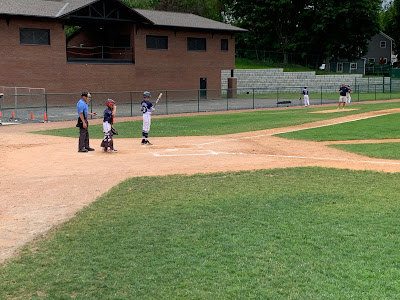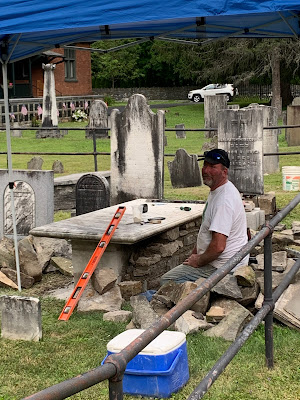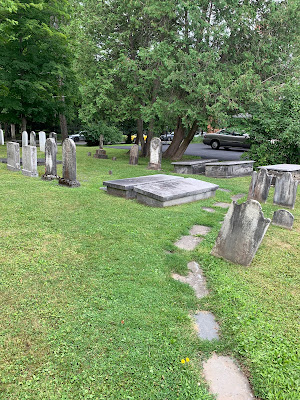We moved on to another RV park in New York so that we could make a visit to Cooperstown and the Baseball Hall of Fame.
There were a lot of other items related to Babe Ruth but this one took the cake.
Yes, that is Babe Ruth in the coffin as people went by to pay their respects. The picture above is from the TV screen that was replaying the news report from 1948.
And, of course, there were a lot of items related to Hank Aaron.
The ball from career home run #715, to pass Babe Ruth's record, is surprisingly not in the Hall but at the Braves' Sun Trust Park.
And because we were Giants fans back in the 60's (boy did my grandma love to sit by the radio and listen to the games), we loved seeing Willie Mays.
Some random items we found interesting.
Below the Bloody Sock During the 2004 ALCS, an incision on Boston pitcher Curt Schilling's surgically repaired right ankle had opened slightly resulting in the famous bloody sock images. In Game 2 of the 2004 World Series, Schilling knew the TV cameras would again focus on the ankle. A supporter of ALS Research, Schilling sought a way to raise awareness of the disease. Despite blood and pain, he pitched six stellar innings, gave up no earned runs, and brought the Red Sox one game closer to breaking their infamous curse. Series viewers watched in fascination, and research into ALS, forever tied to baseball by Lou Gehrig's tragic death, received a boost.
I'll bet you're wondering where the bloody sock is today, right?
While the bloody sock did end up in the Baseball Hall of Fame, it was only there for a short time. Schilling started a video game company called 38 Studios which received a $75 million loan from the state of Rhode Island. The company quickly fell apart and the state sued Schilling in 2012. 38 Studios filed for bankruptcy and the company had to pay the state back $61 million. Perhaps not coincidentally, Schilling auctioned his bloody sock off in 2012 where it brought in $92,613.
Cy Young
Originally nicknamed "Cyclone", Young began his big-league career with the old Cleveland Spiders where he won 241 games from 1890-1898.
Photos below. Top: Red Sox hurler Cy Young at Boston's Huntington Avenue grounds, the predecessor to Fenway Park. 1908. Bottom: Cy Young and his wife, Robba, on their farm, with trophies he later donated to the Hall of Fame, circa 1935.
Cy Young wore this jersey in 1898 with the Cleveland Spiders of the National League, a club with which he won 241 games in just his first nine seasons of big league baseball.
Back to the Giants. I've told this story many, many times but it warrants a repeat. In 1962, the Giants were playing the Yankees in the World Series. My dad was given 2 tickets to a game and being that my sister was the oldest, he took her to the game but promised that the next time the Giants were in the Series he would take me.
Many, many years passed and finally - finally - they made it back to the Series in 1989 playing the cross-town team, the Oakland A's. Imagine my surprise when my phone rang at work one morning and on the other end was my dad. "Debi, I haven't forgotten my promise and I have two tickets to tonight's game. Can you get a flight and get here so we can go to the game together?" Sadly, I had to decline as Ron was out of town and getting a flight would be difficult so I thanked him for fulfilling his promise and we were even. The date was October 17, 1989.
Thankfully, my dad didn't go after all - that was a wild night!
Lou Gehrig's uniform.
Maybe it was because it was just two days after the induction ceremony or maybe it's normal but there were lots and lots of groups of boys/young men touring the museum. They were enthralled with all of the memorabilia and information for them to read about their favorite teams and players. One of my favorite moments of our visit was when one of the boys spotted the display of the World Series rings and yelled "look, the rings!" and the boys all ran over to the display case and whipped out their phones to take pictures.
Who let these fans in?
There was an entire section about baseball in movies with some special items on display.
Timothy Robbins' uniform from Bull Durham
Robert Redford's jacket from The Natural
There's no crying in baseball
And for my sister's family, a very special player. Honus Wagner! He was so special that they even named their cat Honus.
A great section about the announcers that we've all come to love.
Long time Mariners fans suffered through many hopeless seasons. But no matter what happened on the field, we all loved listening to the voice of the Mariners, Dave Niehaus. And we were all thrilled in 2008 when he was the first Mariner to make it into the hall with the Ford C. Frick Award. This award is presented annually by the Hall of Fame to a broadcaster for "major contributions to baseball". My oh my!
Sadly, Dave passed away in 2010 but we will never, ever forget his voice.
And then, it was on to the main event - the Hall of Fame Gallery.
Okay, he went in as an Arizona Diamondback but he played many years in Seattle
We then took a walk down the main street - it is such a quaint little town and is more than just the Hall of Fame.
Did Abner Doubleday really invent baseball in Cooperstown during the summer of 1839? Not only is that story untrue, it's not even in the 'ballpark'. Baseball's real origins date back way farther, to at least the 18th century.
We happened upon a mason who was busy putting new stone around some of the Cooper family graves.
In 1907, sixteen years after Doubleday's death, a special commission created by the sporting goods magnate and former major league player A.J. Spalding was set up to determine baseball's origins - namely was it invented in the United States or derived from games in the United Kingdom. The commission used flimsy evidence - the claims of one man, mining engineer Abner Graves, who said he went to school with Doubleday - to come up with the origin story which managed to stick.
The history of baseball is more complicated than the Doubleday legend. References to games resembling baseball in the United States date back to the 18th century. Its most direct ancestors appear to be two English games: rounders (a children's game brought to New England by the earliest colonists) and cricket.
These kids didn't seem to care who invented the game, they just love playing it.
But there's more to Cooperstown than baseball. The village was developed within part of the Cooper Patent, which William Cooper - who later became a county judge - purchased in 1785. The land amounted to 10,000 acres. William Cooper was the father of James Fenimore Cooper, who grew up in the frontier town. As you probably know, James Fenimore Cooper was a famous author who's works included Last of the Mohicans.
Cooper established the village of Cooperstown in 1786, laid out by surveyor William Ellison. It was incorporated as the "Village of Otsego" on April 3, 1807. The name was changed to "Village of Cooperstown" on June 12, 1812 after the founder. William Cooper was appointed as a county judge in the late 18th century and was elected to the state assembly from Otsego County.
So we took a walk to see and learn more.
Of course you know we'd find our way to the Christ Church Cemetery where many of the Cooper family are interred.
We talked with him for a bit and he told us how much he enjoyed his work because the people were so quiet :-)
The Cooper plot
William Cooper
2 Dec 1754 - 22 Dec 1809
James Fenimore Cooper
15 Sep 1789 - 14 Sep 1851
And with that we were on our way for another big adventure tomorrow. Stay tuned - no history involved.
























































I ALMOST got there in 1974. Long story. It's still on my bucket list.
ReplyDeleteIt's really fascinating but pretty overwhelming. Not enough hours to see it all.
Delete